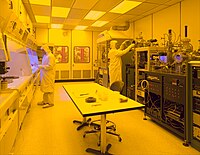
Photo from wikipedia
Abstract Lithium metal is one of the most promising anode materials for lithium rechargeable batteries owing to its high capacity. However, its practical use is not yet realized owing to… Click to show full abstract
Abstract Lithium metal is one of the most promising anode materials for lithium rechargeable batteries owing to its high capacity. However, its practical use is not yet realized owing to safety issues. In this study, we fabricated a Li-coated Ni-mesh and tested it in a Li/Li symmetric and Li/Cu cell. The Ni-mesh is oxidized to make it lithiophilic prior to coating with lithium in a lithium melt. The Li-coated Ni-mesh electrode exhibits a significantly better cycling stability and lower interfacial resistance than those of a pristine lithium-foil electrode. We believe that the good cycling stability is attributed to the suppressed dendritic growth of lithium and fast electron transport along the Ni-mesh. The suppressed dendritic growth of lithium is closely related with the three-dimensional structure of the Li-coated Ni-mesh electrode which i) lower the current density owing to its large surface area, ii) and prevent electron localization at lithium dendrites and iii) the Li2O phase on Ni-mesh which raises transference number of Li+ (tLi+).
Journal Title: Journal of Alloys and Compounds
Year Published: 2019
Link to full text (if available)
Share on Social Media: Sign Up to like & get
recommendations!